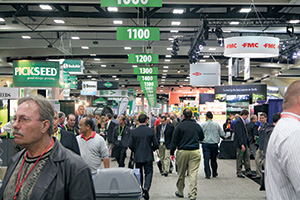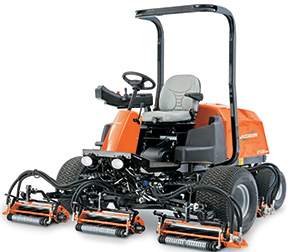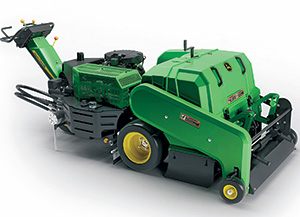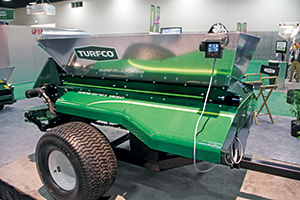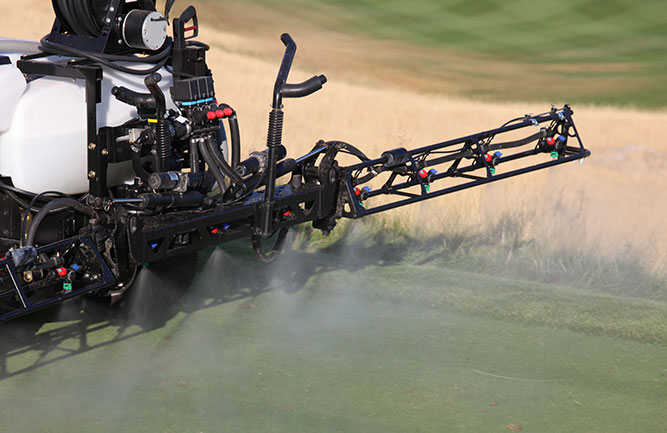Seth’s 2013 GIS Notebook
We can’t read his chicken scratches. We’re glad he can.
I was cruising through an old issue of Golfdom from the 1940s the other day. I skimmed a story written by Golfdom founder Herb Graffis. It went on for pages, and it was all written as if he was talking one-on-one with the reader.
We don’t do that often in modern day journalism. Why? I don’t know. As I read through this article, it made me feel like Graffis was talking to me, and I thought that was pretty cool.
So I decided to borrow Mr. Graffis’ 1940s style for my report on the 2013 GIS.
Now, if you’re saying, “Seth, didn’t you guys already do a report on the GIS last issue?” I’d say, “Thanks for closely reading, and yes! But…”
That story was all about shaking hands and kissing babies, if you know what I mean. We wrote about large donations made to awesome benevolent funds, about the “mood” at the show, about who won the turf bowl. Which is all fine and good, but does any of that help you grow grass? You could make an argument, but…
So let’s just say this “notebook” feature is more of the things I heard from industry people when discussing growing grass, or at least maintaining a golf course. And away we go…
Par Aide
I was walking by the Par Aide booth when I saw my pal Dan Brown, vice president of the company. I’ve had the pleasure of playing some golf with Dan (read: he kicked my butt) so it was good to catch up with him a safe distance from the golf course.
As I’m standing there chatting with Dan, walking toward me is Jeff Plotts, head honcho at TPC Scottsdale, host site of the Phoenix Waste Management Open.
After introducing the two, I had to ask Plotts about the Phil Mickelson lip-out that occurred on No. 18 during the first round of the tournament. Had that putt dropped, Mickelson would have joined the 59 club.
“That was one of the Ever-White Par Aide cups, and it was cut perfectly,” Plotts said proudly. “We love them. Had that putt been down the middle, he would have had the 59!”
Club Car
I cruised over to the Club Car booth, where I met with Dave Hodgson, Club Car’s Visage sales manager for Canada. We talked about the Visage Mobile Golf Information System, which is basically a touch-screen mounted inside the cart, where a rearview mirror might be.
I’ve seen this system evolve over the last couple years. Each year it seems they find an added benefit or two. This year, what caught my ear were two things: One, that courses that have bought into the system have been able to remove golf course signage directing players where they can and can’t drive, because the GPS system already dictates where golfers can and can’t drive. And two, that some superintendents are using the system as a way to communicate directly with golfers.
“Superintendents who are progressive are using it to produce videos,” Hodgson told me. “It can be something as simple as, ‘Hey, we’re going to aerify next week.’ They’re educating golfers in a fun way.”
That’s right — videos of you, the superintendent, speaking directly to the golfer as he makes the drive from the practice putting green to No. 1 tee. That’s crazy enough it just might work…
Toro
I always schedule about an hour to visit with the folks at Toro because they have so much going on. This year was no different. Among other things we talked about their Tier-4-compliant machines, their new partnership with GreensPerfection brushes (mentioned last issue), the Reelmaster 3550-D, the Rounds4Research program and the Multi Pro 1750 and WM sprayers.
These new sprayers made an impression. The tanks have been reconfigured to achieve 99 percent spray-out. There are no nooks or crannies in there for expensive chemicals to get left behind. A six-diaphragm pump is powerful enough to agitate and pump everything out. The 1750 has a tank capacity of 175 gallons while the MW has a 200-gallon capacity. I’m told they’ll be available early next year.
I also met up with David Angier, senior marketing manager for irrigation, and he showed me the Toro Twilight golf lighting system they acquired two years ago. This system allows golfers to work on their putting at night by illuminating golf holes and the surrounding putting area.
I know what you’re thinking; you don’t want golfers on the putting greens at night, you’ve got enough work during the day. But Angiers tells me the system is low-tech so anyone working food and bev can run out and set these up in the evening. Even more important, he tells me some clubs are including this as an add-on to a wedding reception, and they’re netting $500 for an hour of nighttime putting. That might make the GMs sit up and listen…
Jacobsen
Ready for more equipment? I was. I headed over to my next appointment at the Jacobsen booth and got the grand tour of the LF510.
The phrase that best summed it up was, “Jacobsen quality of cut with surprising affordability.” They’ve removed the bells and whistles from the 550 to bring the price point down. As Rachel Luken, product manager, told me, “This is what the market needs — budgets are still tight.”
You might remember the marketing campaign for the LF510. They had the sheet covering the mower, asking people to guess what the machine was. I guessed it was something high tech. Instead Jacobsen went the opposite direction, keeping it simple.
An example of how this machine got simple is in how you control speed on the machine. Out goes an electric speed regulator, in comes a simple mechanical speed control.
Quali-Pro
One of my more interesting meetings came with Jerry Corbett, product management and development manager for Quali-Pro. They have a couple big products out right now, but Corbett really wanted to talk about who Quali-Pro is and what they do.
Corbett said he wants the company to shed the image of being a post-patent chemical company.
“I promise you Quali-Pro can make it as good as anyone in the world. All we do is agro-chemicals,” he told me. “We don’t make pharmaceuticals, we don’t make plastics. We’ll be in this to the bitter end.”
Another interesting thing Corbett told me is that the company will have a nematicide in 2014. He said it has a very green profile, that the EPA found it “boring.”
Back to Quali-Pro’s two noteworthy products this year: Negate and Enclave. Negate is a dual-powered post-emergent herbicide that controls grassy and broadleaf weeds in warm-season grasses. Enclave is a broad-spectrum fungicide using “quad-control technology” and controls snow mold, brown patch, anthracnose and other diseases.
John Deere
The two products I spent the most time looking at this year were Deere’s V40 and AV40 PrecisionCore aerators. Mark Barnes, product marketing manager, gave me the VIP tour of this equipment.
Barnes explained how the edge of some greens holds more water than the rest of the green. In order to deal with this, the V40 and AV40 can be adjusted on the fly, without stopping. So an operator could go from a 2-inch hole spacing to a 1-inch spacing and then right back to the 2-inch.
I liked this: it comes with a refuel warning to prevent guys getting ditched on the furthest hole from the shop. There’s a light that comes on, yes, but if it gets really low, the machine won’t even drop the coring head. Also cool, the machine has an articulating frame so coring depth remains consistent, even over greens with a lot of undulation in them.
Arysta
Ran into Doug Houseworth, Ph.D., at Arysta Lifescience. We talked about how Xonerate for Poa control was doing. He said some users were shocked at what the product did right off the bat — eradicate Poa mercilessly down to the dirt — and were surprised by the drastic results.
“It’s a little like plastic surgery,” Houseworth said, “You look awful for a short period, then you look great.”
Houseworth then got into a popular topic — plant health. He said some of his competitors were owning that phrase, but that Arysta would be making a push as well. “Our strobilurin is equal to or better than anything they’ve got,” he said.
Ostara
We go from Arysta to Ostara.
I wasn’t familiar with Ostara, or their Crystal Green fertilizer. When I got to their booth, they asked me to run my hands through a tray of white granules, which of course I did. I’m very trusting at trade shows, apparently.
But there was a point to what the folks at Ostara had me do — they wanted to show me that these granules are very clean, hard and dust free… which makes for easy blending.
I was running my hands through a slow-release form of phosphorous, nitrogen and magnesium. It’s also a sustainable product, as it’s produced by recovering phosphorous from renewable resources. Crystal Green is citrate-soluble with low water solubility, making the granules release slowly over the growing season. The nutrients are slowly distributed in response to plant demand, the company says. So when the roots are satisfied, Crystal Green stops releasing until the next growth period.
Clearly, it’s all over my head — I’m the guy who runs his hands through random stuff at conventions, after all — but lucky for me, more can be learned at crystalgreen.com.
Turfco
I stopped by the Turfco booth to visit with Scott Kinkead, executive vice president. He told me that the Widespin 1550 underwent some improvements. Among them, it has 20 percent more capacity, a wider hopper opening and a better system for knowing what your application is. They’ve gone to what they call the “app culture” and made an easier-to-use home screen so it’s not up to the superintendent (or the most mathematically gifted guy on the crew) to set the rate. Now you can just plug in the “greens” rate and it automatically goes to what the superintendent has pre-programmed. Push the “fairways” button, and… you get it.
The TriWave 40 also got some work done. It used to be this was a reactive piece… guys only took it out when there was a problem. Now it can be backed up to a Gator and on the course faster, making it easier to use for preventative maintenance. “For the first time ever, a guy can go out every two weeks and just touch up problem spots,” Kinkead said.
•••
OK, that’s all the space I have for this issue, but I promise you there’s more in my notebook. I’ll share it as the year goes on in our regular “Golfdom Gadgets” feature.






